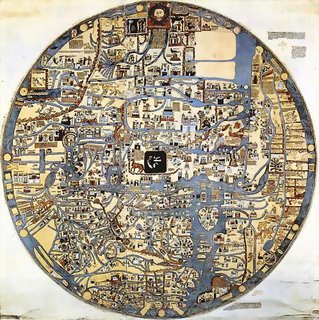
In a thirteenth-century map of the world discovered in 1830 in the Benedictine Abbey of Ebstrof, the whole of terrestrial creation is pictured, in typical medieval fashion, as a circle, with Jerusalem as its center. The entire image is, as it were, superimposed on the body of Christ, whose extremities represent the directions of the compass: the head of Christ in the east, his hands at north and south, and his feet marking the west. Looking at this map, one is forced to orient oneself not according to modern standards of objectivity, but, one might say, as a reader. After all, the map is structured as a complex organization of narratives, with what now seems like bizarre and superfluous information not found on modern maps of the world: architectual structures, animals, human beings, and text.It quickly becomes apparent to the modern observer that to make sense of the Ebstorf mappamundi, it must be read. It cannot simply be seen and understood; its foreign idiom must somehow be taught, learned, and inhabited....In other words, it suggests a mode of reading which is less the comprehension of a tableau that the performance of a sequence of movements.
Yet it also seems to indicate that to read the world rightly is to read it in Christ, and that the world itself is rendered intelligible only by seeing it as a kind of diaphonous veil which simultaneously hides and discloses the God who creates it....All of creation, it is implied, gathers its meaningfulness from its orientation to Christ the head, the only true agent of knowledge.
What I find very stimulating from Candler's reflection is the dislocation and disruption of the modern reader and modern 'textuality'. For those of us who teach, or will teach, theology to young, budding minds, this reflection might prove very useful in the classroom. Needless to say, I'm anxious to keep reading!
3 comments:
Charles,
thanks for stopping by. Yes I do have an interest in Bavinck, especially his Trinitarian theology. I've also enjoyed reading Berkouwer (especially Holy Scripture and his book on Barth). I'll pop by your blog shortly.
Patrick
thanks for this wonderful image and text Patrick, as well as the reference to the book! dt.
Post a Comment